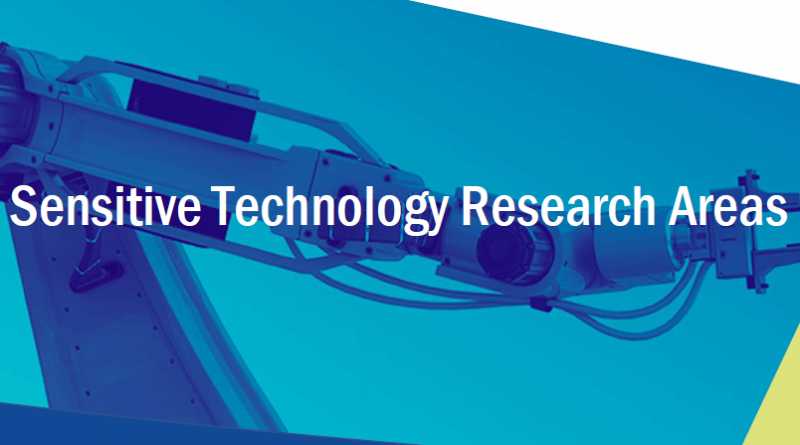Canada’s Sensitive Technology Research Areas
8. Human-Machine Integration
Human-machine integration refers to the pairing of operators with technology to enhance or optimize human capability. The nature of the integration can vary widely, with an important dimension being the invasive nature of the pairing.
Brain-computer interfaces
Interfaces that allow a human to interact with a computer directly via input from the brain through a device that senses brain activity, allowing for research, mapping, assistance or augmentation of human brain functions that could enable improved cognitive performance or communication with digital devices.
Exoskeletons
External devices or ‘wearable robots’ that can assist or augment the physical and physiological performance/capabilities of an individual or a group.
Neuroprosthetic/cybernetic devices
Implanted and worn devices that interact with the nervous system to enhance or restore motor, sensory, cognitive, visual, auditory or communicative functions, often resulting from brain injury. This includes cybernetic limbs or devices that go beyond medical use to contribute to human performance enhancement.
Virtual/augmented/mixed reality
Immersive technologies that combine elements of the virtual world with the real world to create an interactive virtual experience. An application of these technologies that several companies are developing is the ‘metaverse’ which is an immersive digital experience that integrates the physical world with the digital one and allows users to interact and perform a variety of activities like shopping and gaming, seamlessly in one virtual ecosystem. While still being explored, this could potentially translate into a digital economy with its own currency, property and other goods.
Wearable neurotechnology
Brain-computer interfaces that are wearable and non-invasive (i.e. do not need to be implanted). These wearable brain devices can be used for medical uses, such as tracking brain health and sending data to a doctor to inform treatment, as well as for non-medical applications related to human optimization, augmentation or enhancement, such as user-drowsiness, cognitive load monitoring or early reaction detection, among others.
9. Life Science Technology
Life science technology is a broad term that encompasses a wide array of technologies that enhance living organisms, such as biotechnology and medical and healthcare technologies.
Biotechnology
Biotechnology uses living systems, processes and organisms, or parts of them, to develop new or improved products, processes or services. It often integrates other areas of technology, such as nanotechnology, artificial intelligence, computing and others, to create novel solutions to problems, including in the area of human performance enhancement.
Biomanufacturing
Methods and processes that enable the industrial production of biological products and materials through the modification of biological organisms or systems. Advances in biomanufacturing, such as automation and sensor-based production, has led to commercial-scale production of new biological products, such as biomaterials and biosensors.
Genomic sequencing and genetic engineering
Technologies that enable whole genome sequencing, the direct manipulation of an organism’s genome using DNA, or genetic engineering to produce new or modified organisms. Examples include: Clustered Regularly Interspaced Short Palindromic Repeats (CRISPR) and Next Generation Sequencing (NGS).
Proteomics
Large-scale and experimental analysis of protein, proteomes and proteome informatics. Proteomic applications can be used for the identification of unknown bacterial species and strains, as well as species level identifications of tissues, body fluids, and bones of unknown origin.
Synthetic biology
Combination of biology and engineering to create new biological entities, such as cells or enzymes, or redesign existing biological systems, with new functions like sensing or producing a specific substance. Synthetic biology is expected to enable advancements in many areas, such as antibiotic, drug and vaccine development, biocomputers, biofuel, novel drug delivery platforms, novel chemicals, synthetic food, and synthetic life.
Medical and Healthcare Technology
Medical and healthcare technology refers to tools, processes or services that support good health and prevent, or attempt to prevent, disease. Advances in biotechnology, nanotechnology and advanced materials are enabling new methods of delivering medicine or treating injuries, diseases or exposure to toxic substances.
Chemical, Biological, Radiological and Nuclear (CBRN) medical countermeasures
Various medical assets used to prevent, identify or treat injuries or illnesses caused by chemical, biological, radiological or nuclear (CBRN) threats, whether naturally-occurring or engineered. CBRN medical countermeasures include therapeutics to treat injuries and illnesses, such as biologic products or drugs, as well diagnostics to identify the threats.
Gene therapy
Use of gene manipulation or modification in humans to prevent, treat or cure disease, either by replacing or disabling disease-causing genes or inserting new or modified genes.
Nanomedicine
Use of nanomaterials to diagnose, monitor, prevent and/or treat disease. Examples of nanomedicine include nanoparticles for targeted drug delivery, smart imaging using nanomaterials, as well as nano-engineered implants to support tissue engineering and regenerative medicine.
Tissue engineering and regenerative medicine
Methods of regenerating or rebuilding cells, tissues or organs to allow normal, biological functions to be restored. Regenerative medicine includes self-healing, where the body is able to use its own tools or other biological materials to regrow tissues or cells, whereas tissue engineering largely focuses on the use of synthetic and biological materials, such as stem cells, to build function constructs or supports that help heal or restore damaged tissues or organs.





